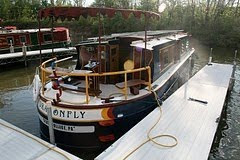And we have a winner! Erik Saunders, please step forward.
Erik correctly identified those nifty little fanny packs as stealth PFDs (personal flotation devices).
You may be more familiar with the term "life jacket." But as you can see, a life-saving flotation device doesn't have to look like a coat or vest.
We Pause for This Public Service Message
PFDs save lives. In 83% of recreational boating deaths by drowning, the victim was NOT wearing a PFD.
The best PFD is . . . the one you are willing to wear. Lots of people say they don't wear a PFD because it's hot or bulky.
Parks Canada is keeping its personnel safe by 1) requiring them to wear PFDs and 2) choosing PFDs that are easy to wear: comfortable and inobtrusive. Good on ya, Parks Canada.
How Does a Fanny Pack PFD Work?
 |
| This kind of life vest is also cool and lightweight. |
(You can also inflate the PFD manually, by blowing in a tube.)
Scott Barbara of U.S. Power Squadron is a boating safety expert. He notes that the locktenders really need to be wearing their fanny packs in front, not in back.
When the life vest deploys, you need to pull it up over your head--which is hard to do when it's behind your back!
Try It BEFORE You Need It
Scott also recommends that, if you plan to use a fanny pack PFD, you test-drive it before you need it. Fall into the water on purpose and practice getting the vest over your head.
Good advice, Scott! (You'll then have to buy a replacement CO2 cartridge, but worth it for the peace of mind.)
When I'm out on our boat's catwalk in a lock, and the boat is heaving and sloshing around in the turbulence as the lock fills, and I contemplate the narrow gap between the boat and the wall, and what might happen if I were to fall in, well, wearing a PFD sounds pretty darned good!


























































